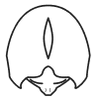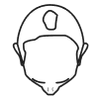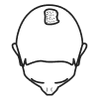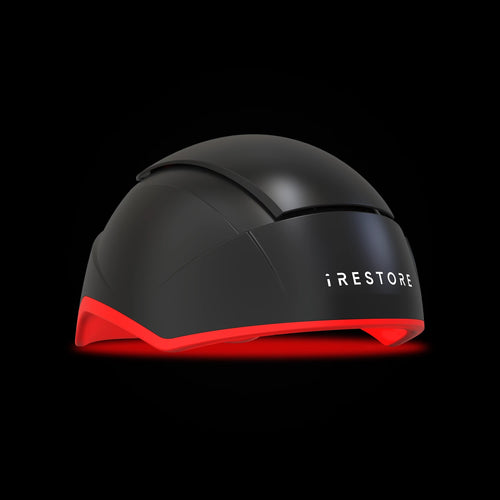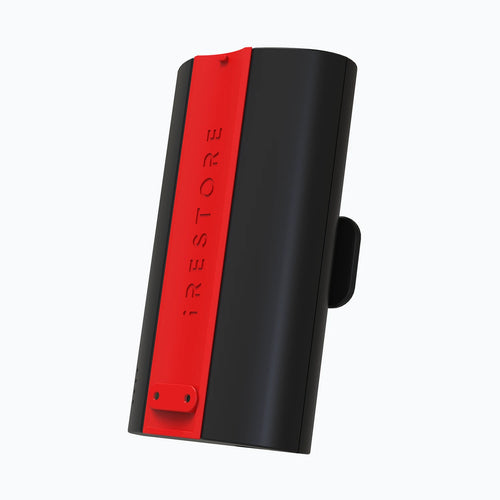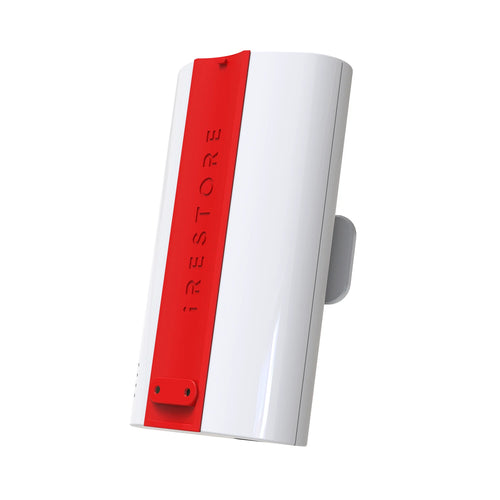When you look in the mirror, it’s not always easy to tell whether your hair is thriving or quietly struggling. Understanding the signs of healthy hair vs signs of unhealthy hair helps you catch early damage before it turns into breakage, thinning, or persistent dryness. According to the American Academy of Dermatology, more than 40% of people don’t notice hair damage until breakage becomes visible, which means early detection matters more than most realize.
Healthy hair reflects what’s happening inside the follicle: strong structure, good moisture balance, and an active growth cycle. Unhealthy hair, on the other hand, often shows changes in texture, shine, elasticity, or shedding patterns long before actual thinning begins. Many people confuse damage with loss, which is why guides like new growth vs breakage are important in helping you understand what’s really happening.
Because hair is a direct reflection of scalp health, environmental exposure, and daily habits, learning how to recognize healthy vs unhealthy hair gives you the power to take action early. And the good news? Most early signs of unhealthy hair—dryness, rough texture, breakage, and dullness are reversible with the right routine and scalp support.
What Healthy Hair Looks Like
When your hair is truly healthy, it shows consistent signs of healthy hair across texture, shine, strength, and scalp condition. Healthy strands have a smooth outer cuticle layer that reflects light evenly, giving hair a natural shine not greasiness. Research shows that hair with an intact cuticle has up to 50% better moisture retention, which is why it feels soft and looks glossy.
Another major indicator of healthy hair is elasticity. Healthy strands can stretch up to 30% of their length when wet without snapping; this means the internal protein structure is strong. If your hair bounces back easily when brushed or styled, that’s a great sign your moisture and protein balance is intact.
Healthy hair also sheds predictably. It’s normal to lose 50–100 strands per day, but the strands you shed should generally be full-length and not tiny broken pieces. A healthy scalp is just as important. A balanced scalp should feel clean, calm, and free of buildup. Research shows that a stable scalp microbiome is closely linked with lower rates of inflammation and hair fiber weakening, which is why scalp-friendly habits matter. If you’re unsure whether your scalp is contributing to hair problems, refer to what does damaged hair look like to identify early signs.
Porosity also plays a role in determining whether hair is thriving. Low-to-medium porosity often signals strong, healthy cuticles, while very high porosity usually indicates past heat, chemical, or environmental damage.
Signs of Unhealthy Hair
Unhealthy strands usually show early warning signs long before thinning becomes visible. One of the clearest signs of unhealthy hair is a rough, dull texture. When the cuticle layer is damaged, it no longer reflects light evenly, making hair look lifeless. Research shows that damaged cuticles increase friction by up to 45%, causing frizz, tangles, and breakage.
Another indicator of unhealthy hair is frequent breakage. Unlike natural shedding where strands fall out from the root breakage leaves behind short, snapped-off pieces with tapered or uneven ends.
Tangles and knotting are common when the hair’s protective layer is compromised. Studies show that cuticle lift or erosion makes strands 70% more prone to tangling, especially when wet. If your hair becomes impossible to detangle even after conditioning, that’s an early sign of damage or dehydration in the fiber.
Weak, thinning strands are another sign. When hair loses internal protein structure, it becomes fragile, resulting in wispy ends, loss of thickness, and reduced strand strength. The early stages of miniaturization often look like strand weakness before density loss. To understand this process better, see iRESTORE’s guide on hair miniaturization which explains why thinning strands often signal deeper follicle stress.
A compromised scalp is also a major contributor to unhealthy hair. Dandruff, buildup, irritation, or an oily/dry imbalance can suffocate follicles and lead to dull, brittle strands. Research links scalp inflammation with significant increases in breakage and fiber weakening. If buildup or inflammation is an issue, iRESTORE’s guide on scalp massage for circulation
Key Differences: Healthy vs Unhealthy Hair
|
Category |
Signs of Healthy Hair |
Signs of Unhealthy Hair |
|
Texture |
Smooth, soft, uniform texture |
Rough, dry, coarse, inconsistent texture |
|
Shine |
Natural, even sheen (not greasy) |
Dull, matte, lifeless appearance |
|
Elasticity |
Stretches up to ~30% when wet without breaking |
Snaps easily; little to no elasticity |
|
Strength |
Strong strands that resist snapping |
Breakage, weak strands, uneven ends |
|
Shedding |
50–100 full-length strands/day (normal) |
Broken pieces, excessive shedding, short snapped hairs |
|
Scalp Condition |
Balanced, clean, calm, minimal buildup |
Itchy, flaky, irritated, oily or very dry |
|
Porosity |
Low–medium porosity; retains moisture well |
High porosity; absorbs moisture fast but loses it quickly |
|
Manageability |
Easy to brush and detangle |
Tangles frequently; hard to manage |
|
End Health |
Minimal split ends |
Visible split ends, fraying, rough tips |
|
Overall Appearance |
Bouncy, shiny, feels alive |
Limp, flat, frizzy, brittle |
What Causes Hair to Become Unhealthy?
One of the most common reasons people see signs of unhealthy hair is heat damage. Flat irons, curling tools, and blow-dryers can raise the hair’s cuticle temperature beyond 150°C, which weakens the protein bonds that give hair its strength. Studies show that repeated high-heat exposure increases breakage by more than 85%.
Chemical treatments like coloring, bleaching, relaxing, and perming also cause significant structural damage. These treatments break down keratin and disrupt the hair’s internal moisture balance. Research shows that bleaching alone can raise hair porosity by up to 40%, making strands brittle and more prone to snapping. To understand porosity changes better, you can read what is hair porosity here.
Another major contributor to unhealthy hair is product buildup. When oils, styling products, dry shampoo, and pollutants accumulate on the scalp, they block follicles and disrupt the natural moisture environment. Research links scalp buildup to increased inflammation and a higher rate of cuticle erosion, which accelerates frizz and breakage.
Nutritional gaps also play a direct role in unhealthy hair. Deficiencies in iron, vitamin D, zinc, biotin, and protein weaken the hair fiber and growth cycle. Studies show that over 70% of women with diffuse thinning have at least one nutrient deficiency affecting strand health.
Environmental factors like UV radiation, humidity, cold weather, and pollution can damage the cuticle and dehydrate the hair fiber. UV exposure has been shown to reduce hair strength by up to 30%, especially in lighter or chemically treated hair.
How to Improve Unhealthy Hair?
Improving unhealthy hair starts with restoring balance to your scalp and strengthening the cuticle. One of the most effective ways to do this is through gentle, consistent scalp care. A clean, balanced scalp helps follicles function properly, reduces buildup, and supports healthier strand production.
Another key factor in repairing unhealthy hair is restoring moisture and protein balance. Dehydrated strands lose elasticity and become prone to breakage. Using hydrating conditioners, leave-ins, and protein-based treatments can help smooth the cuticle and reduce breakage by nearly 40–60%, according to cosmetic science studies.
Heat and chemical reduction also make a massive difference. Excessive flat-ironing, bleaching, relaxing, or coloring can raise the cuticle permanently, making hair rough and fragile. Research shows that chemical treatments can increase porosity by up to 40% and weaken the hair fiber significantly.
Supporting the hair growth cycle is another powerful way to restore healthy strands. Stress, sleep deprivation, postpartum shifts, and nutritional gaps can disrupt the cycle, causing weak, wispy strands. Stabilizing your routine with sleep, nutrient-rich foods, and scalp stimulation helps return follicles to normal rhythm.
For many people, red light therapy (LLLT) is an effective way to support follicle function from the root. LLLT increases cellular energy (ATP), improves microcirculation, and strengthens follicles from within: all of which help reverse the signs of unhealthy hair over time. Clinical trials show that red light therapy can increase hair density by 20–25% in early thinning cases. If you’re curious how this works, iRESTORE has a detailed guide on how red light therapy reduces shedding.
iRESTORE’s Red Light Therapy
Red light therapy is one of the most researched non-invasive ways to improve the signs of unhealthy hair by supporting follicle function at the root. Low-level light therapy (LLLT) works by increasing cellular energy (ATP) in the follicle, which helps support stronger, thicker strands. One of the reasons LLLT is effective for damaged or weakened hair is its ability to improve microcirculation. Better circulation means more oxygen and nutrients reach the follicle, which strengthens the new hair that grows out.
Consistency is key with LLLT. Most people begin seeing improvements in shine, reduced breakage, and healthier texture after 8–12 weeks, with more noticeable density improvements after 4–6 months of regular use. Overall, red light therapy is a supportive, drug-free option that strengthens hair from the inside out, helping reverse dryness, brittleness, breakage, and dullness while promoting the signs of healthy hair over time.
Real People, Real Results
Many people don’t realize their hair is struggling until breakage, dullness, or thinning become visible but once they start supporting their scalp and follicles consistently, improvements often show up sooner than expected. iRESTORE users frequently share how their hair begins to feel smoother, less tangled, and much stronger within weeks of improving their routine or adding red light therapy. These small changes, reduced breakage, softer texture, new baby hairs, and a natural return of shine are some of the earliest signs of healthy hair making a comeback. And while results vary, real experiences from real people highlight one thing clearly: when you give your scalp and follicles the support they need, your hair often responds in visible, confidence-boosting ways.

Conclusion
Understanding the signs of healthy hair versus the signs of unhealthy hair gives you a huge advantage because hair rarely becomes damaged overnight. Texture, shine, elasticity, shedding patterns, and even the way your hair handles moisture all reveal what’s happening inside each strand and at the follicle level.
By supporting your scalp, keeping your routine gentle, and giving your follicles the consistency they need, you can help your hair regain strength, softness, and smoother texture over time. Every positive change is a sign you’re headed in the right direction, and if you’re ready to support that journey further, exploring iRESTORE’s red light therapy Hair Growth System Elite can be a gentle next step to help nourish your scalp and energize your follicles.
FAQs
1. What does healthy hair feel like?
Healthy hair feels smooth, soft, and flexible. It stretches slightly when wet without snapping and has a natural shine due to a flat, intact cuticle layer, one of the clearest signs of healthy hair.
2. Why is my hair always dry or rough?
Dryness and rough texture are common signs of unhealthy hair. This can happen due to heat styling, chemical treatments, sun exposure, or high porosity. When the cuticle lifts or cracks, moisture escapes quickly, leaving hair dehydrated.
3. Can unhealthy hair become healthy again?
In most cases, yes. Early dryness, breakage, roughness, and dullness can often be reversed with gentle care, moisture–protein balance, and scalp support. Consistency is key when restoring the signs of healthy hair.
Disclaimer: The information in this article is for educational purposes only and is not intended as medical advice, diagnosis, or treatment. Hair and scalp conditions vary from person to person. If you have concerns about persistent shedding, irritation, or sudden changes in hair or scalp health, we recommend consulting a qualified healthcare professional.




